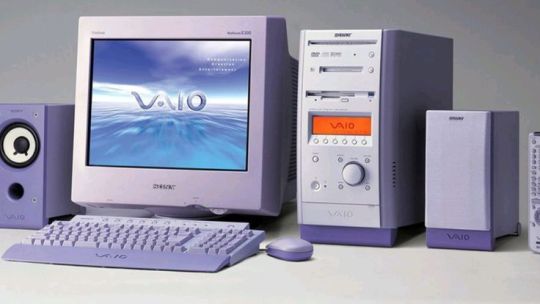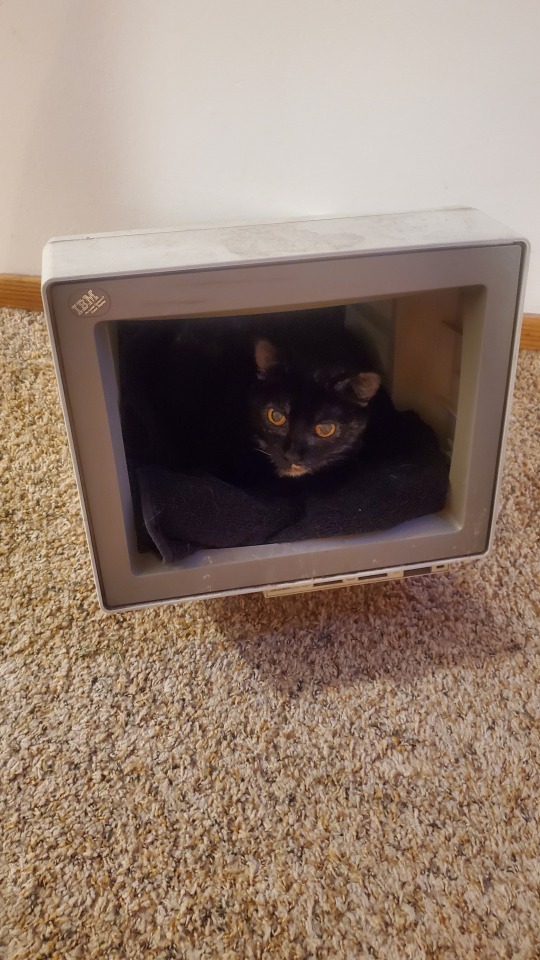#computer monitor
Explore tagged Tumblr posts
Text


#art#computer#computer monitor#cybercore#cyber y2k#design#desktop#electronic#future#futuristic#futurism#graphic design#graphics#kaybug#laptop#sony#sony vaio#tech#technology#y2kcore#y2kore#y2k aesthetic#y2k core#y2k cyber#y2k design#y2k futurism#y2k graphics#y2k#y2k nostalgia
735 notes
·
View notes
Text



Alien: Covenant (2017)
#Alien: Covenant#Alien Covenant#scifiedit#computer monitor#computer graphics#cgi#solar system#filmgifs#movieedit#GIF#my gifs#10sedit#aliencovenantedit#Alien Covenant Rewatch#Hide and Queue
205 notes
·
View notes
Text
Computer monitors work by very quickly turning lights on and off to trick your brain into perceiving colour.
100 notes
·
View notes
Text




#art#black#blue#computer monitor#computer mouse#computer#design#desktop#electronic#frutiger aero#gadgets#graphic design#graphics#object#tech#technology
73 notes
·
View notes
Text

First piece of the year?? Yes!!
If you find an old computer monitor in the forest, it will have gained knowledge of many things that are unknowable to most, but because the monitor is inanimate, it cannot express this to any being in a tangible manner. What a difficult position to be in!! Oh no!!
#first piece of the year#i love the idea of beings that live inside electronics (functional or otherwise)#it just scratches my critter brain in the right way YA KNOW#foxes#foxkin#forest#computer monitor#abandoned#ink#bw#fox#ethereal#sadanimalcore#caninekin
18 notes
·
View notes
Note
Computer q. For otherwise identical monitors, is a 4000:1 contrast ratio noticeably better from 1000:1? I don't mean for fancy art but like if I'm watching a movie, could I see the difference in a dark scene? I looked into oled's, but those are expensive and I think the way I use my stuff would cause burn in.
I hope you don't mind, but I got carried away and answered pretty much every computer monitor question anyone has ever had. And since this turned into a whole thing, I thought I'd share it for everyone to benefit.
For a computer monitor I would say the most important aspect is actually the viewing angle. This is how far off-axis you can look at the monitor before the image degrades.
We sit very close to our displays and at that distance, even a change in height in your chair can affect the image. Move a little bit left or right and a cheap display could completely wash out and look terrible. And if you get a display that is 27" or above, even if you sit dead center, the edges of the screen will appear dark and washed out with a bad viewing angle.
The two best display technologies to get a good viewing angle are IPS (in-plane switching) and OLED. If you are interested in a display without these technologies, be sure it has a decent viewing angle. You can read more about viewing angles here and here.
IPS has very little concern for burn-in, but it is still a concern with OLED. In recent years OLED has greatly improved and image retention and burn-in can be avoided with regular maintenance. Displays will have pixel shift features and noise modes that work out all the pixels evenly. You can run these features every once in a while to prevent burn-in. You can also play special anti-burn-in videos on YouTube (full screen) to exercise the pixels to uniformity.
So if you don't mind the hassle, you can manage an OLED with low risk.
That said, OLED was almost exclusively for TVs and has only recently been introduced for computer displays. The current options are quite large and fairly expensive, as you alluded to. So if you are trying to stay within a budget, it might be best to seek out an IPS display.
Another consideration is resolution. Everyone is obsessed with everything being 4K now. But I think increasing the resolution brings diminishing returns with regard to increased detail you can actually notice. So if you don't mind going with a 1440p monitor (about 2.5K), you can save some money on resolution and get higher quality in more noticeable areas. Personally, I feel 1440p gives you a nice, noticeable bump in detail over 1080p. Whereas going from 1440p to 4K (2160p) is less noticeable unless you have very good vision.
Another benefit to 1440p is that video games are much easier to run on high quality settings with a reasonable GPU. And you can use technologies like super sampling (Nvidia calls this DLSS) to increase the detail you may lose from not going 4K.
The only concern I'd have with not going 4K is if you edit 4K video. It will be difficult to do a pixel level analysis of your footage otherwise. But other than that, you can still watch 4K content on a 1440p monitor and because it is being downsampled, you will still notice a nice bump in detail.
So if you don't have a reason to get a 4K display, I think 1440p is worth considering.
The next concern would be color. Or color gamut. This is how many colors the display can accurately reproduce. If you don't do any art or video color grading, you'll at least want something that does 95 to 100% of sRGB. That is the color space the entire internet uses. And if you are going to be watching HDR movies, you might want a display with a decent percentage of the P3 color space as well. Doesn't need to be 100%, but the higher the better. And for those who do art, a good percentage of Adobe RGB is recommended.
Also, many manufacturers offer displays that come pre-calibrated from the factory. If color accuracy is important, I would seek out one of these displays with a Delta E rating of 3 or less (lower is better).
A newer factor in displays is peak brightness. This is measured in "nits." In standard dynamic range (SDR), video only needed to reach 100 nits. Most HDR content is mastered to reach 1000 nits. In the future, that number will be 4000. And if micro LED technology ever becomes affordable, we may go up to 10,000 nits. But almost everything is around 1000 at the moment, so that is a good number to shoot for.
HOWEVER, because HDR is tone mapped (the brightness of your display is factored in and the content is adjusted accordingly), you can still get some benefits of HDR, even if you cannot do the full 1000 nits.
All monitors can do 100 nits for SDR content. But with more things being displayed in HDR, having more nits will give you a better experience. This does not mean your display will blind you. Usually bright stuff only takes up a small portion of the screen. But having more nits allows highlights to really pop and feel immersive. A lightsaber might actually feel hot and dangerous on a bright enough screen.
Computer displays are often rated as HDR400 or HDR600 or HDR1000 based on their nits. The HDR400 isn't great for HDR content. If you can do 600 or above within your budget, you'll get a better experience. If you are going to watch movies, this may be a feature you prioritize.
I know you mentioned contrast ratio, but I'm afraid that is a little complicated to answer. It can depend on other aspects of the monitor and the viewing environment. So I'll try to give you the info you need to figure out if the display you select will suit your needs.
Manufacturers can use tricks to fudge their contrast ratio in product descriptions, so it is best to go to an independent review website like RTINGS to see what they measured. (They do good TV and monitor reviews too.) You'll see that OLED displays are said to have "infinite" contrast ratio, due to being able to turn off pixels completely. Which means it is probably time to move to a new metric because that gives very little info on the dynamic range of the display (the difference between the darkest and brightest thing it can show).
You definitely want a decent contrast ratio for your display, but this can be subjective. If you have a nice bright screen, your brain may feel the contrast is fantastic, even if the actual darkest black point of the monitor isn't great. If something is really bright, then dark things will *seem* darker by comparison. And if you are viewing in a dark environment, the contrast will look even better. So this is where seeking out a professional reviewer's experience of the monitor can be helpful. One monitor's 4000:1 ratio might be a different experience than another with the same measurement.
Because TVs are generally larger and can have more backlighting zones, they can get decent black levels without OLED. But smaller computer displays have more difficulty in reasonable price ranges. So manage your black level expectations if you go with an affordable IPS display. They can get bright, but they aren't great at blacks like OLED. I'm afraid that is just a limitation of the tech. In fact, getting a brighter display might be preferable to a better contrast ratio. And it will be easier to see if you are in a bright environment.
Most IPS displays are going to be between 1000:1 and 5000:1 and while it does make a difference, if you sit it next to an old plasma or an OLED, you're going to be disappointed. So I would not make contrast ratio a super high priority with IPS, because non-OLED computer displays just aren't going to give you inky blacks. I would say 2000:1 or better is going to give you a decent experience. But, again, I would seek out reviews rather than trust the official product specs when it comes to the quality of the blacks.
And one final consideration you may want to factor in is the refresh rate. This is mostly for gaming. Most displays will give you at least 60 Hz or 60 "refreshes" per second. Gamers tend to like 120 Hz or higher. This won't affect movie watching very much as nearly everything except Gemini Man is 24 fps.
TLDR overview...
Get an IPS or OLED display for a good viewing angle. I personally feel this is the most important feature.
Choose a resolution. 1440p can allow you to increase quality in other areas to maximize your budget. Only get 4K if you have a legit reason or you have fighter pilot vision.
Color gamut or number of colors. Try to get 100% of sRGB for web content, 90% or above of Adobe RGB for art/photography, and 90% or above of P3 for HDR movies and video editing.
If color accuracy is important, look for pre-calibrated displays that have a Delta E of 3 or less. (Lower is better)
HDR brightness. If you want to experience good HDR, you'll want the brightest screen possible (measured in nits). HDR600 or HDR1000 are great. If you don't care about HDR, then don't worry about the rating.
Contrast ratio and black levels. It's going to be meh on pretty much anything but OLED. 2000:1 or better is a good goal to shoot for, but be sure to check independent reviews for the subjective experience of the black levels. Dark viewing environments help too.
Refresh rate. 60 Hz is fine for most things. Gamers prefer 120 Hz or faster. And if you are a competitive gamer, you may want to seek out more info on "variable refresh rate" and "pixel response time."
Pick the variables above that seem most important to you and then seek out a display that does those things decently within your budget.
78 notes
·
View notes
Text


VIRA computer monitor plushie I made for @wurmey a while back! very excited to share her now :D would love to make more object plushies in the future, boxy shapes are a lot of fun <3 I'm super happy with how the face turned out on this one too!
11 notes
·
View notes
Text
rating aspect ratios
1:1 - too normal. no room for variety. shes not dynamic. but shes a classic, and the best for profile pics. 5/10
16:9 - ugly. too long. 3/10.
16:10 - trying to hard to be 16:9. he wants to be the standard but hes not quite there. 1/10
5:4 and 4:5 - shes perfect. shes cute, shes only barely a rectangle, which is the best size for a rectangle. 10/10
4:3 - a classic. cant go wrong with her. i always think of the 4chan post about her being best for first person shooters. more focused fov, like a predator animal. 6/10
9:16 - perfect shape for a phone. which is good, because hes the aspect ratio for a phone. infinitely better than his cousin 16:9. 7/10
#my opinions are absolute#i will be taking no criticism#/j#um what to tag this#aspect ratio#i GUESS#computers#idk#monitors#like the#computer monitor#yeah.. thats a good one#digital art#because i thought of this while choosing a canvas#i chose 4:5 btw#habit post
4 notes
·
View notes
Text


I GUTTED AND OLD COMPUTER MONITOR TO MAKE A CAT BED
#skin-quilt#skinquilt#skin quilt#art#minneapolis#minnesota#4-24#project#cat#animal#computer#monitor#computer monitor#cat bed
3 notes
·
View notes
Text
4 notes
·
View notes
Text

C'mon Jer.
#business#businesscore#retro tech#old computers#office space#vaporwave#retro#nostalgia#business memes#telemarketing#computer monitor#90s aesthetic#90s#90s fashion#orientation
1 note
·
View note
Text





#accessories#art#black#blue#computer monitor#computer mouse#computer#desktop#design#electronic#frutiger aero#frutiger aurora#gadgets#graphic art#graphic design#graphics#illustration#tech#technology#vector
50 notes
·
View notes
Text

AMSUNG 27" CF39 Series FHD 1080p Curved Computer Monitor, Ultra Slim Design, AMD FreeSync, 4ms response, HDMI, DisplayPort, VESA Compatible, Wide Viewing Angle, LC27F398FWNXZA, Black
#Computer Monitor#ComputerMonitor#MonitorSetup#TechGear#DisplayTechnology#ScreenTime#WorkFromHome#ProductivitySetup#OfficeTech#DualMonitorSetup#ErgonomicSetup#GamingMonitor#144HzMonitor#240HzMonitor#UltraWideMonitor#4KMonitor#DeskSetup#MinimalSetup#RGBSetup#Battlestation#TechAesthetic
0 notes
Text


I've been using a 5:4 monitor for everything this past month because I've been too lazy to swap my monitors. I just switched back to my main 16:9 monitor and its soooo weird. Everything is so wide & there's so much empty space wtf. Like look at these screenshots & you can completely understand.
1 note
·
View note

